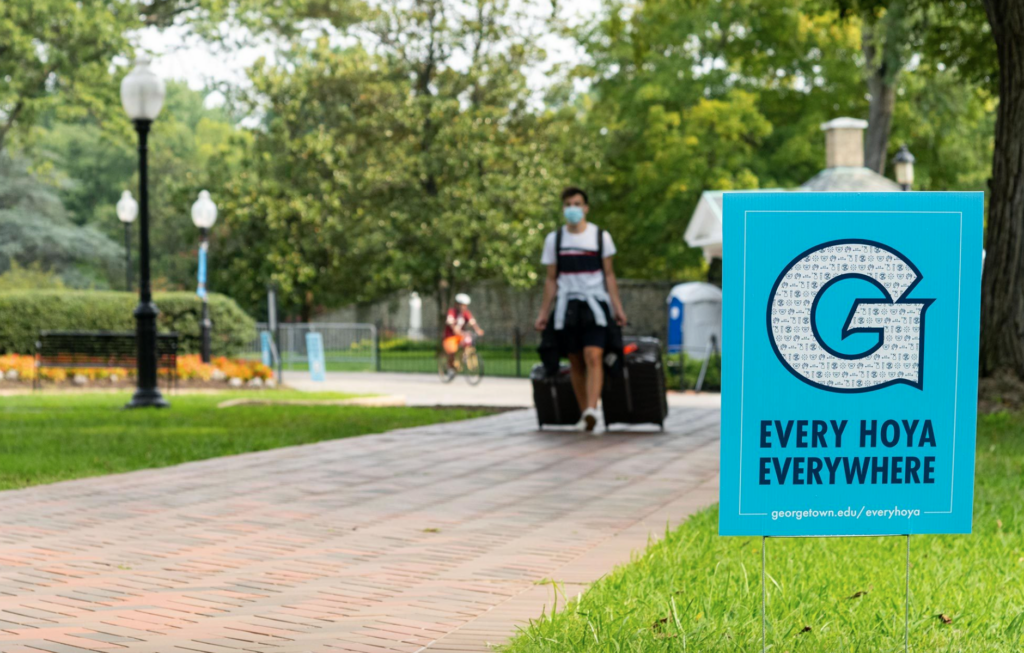Georgetown University is experiencing a rapid increase in COVID-19 cases among undergraduates, according to an email sent to community members Feb. 3.
In the week of Jan. 29, 127 COVID-19 cases were reported, compared to 91 cases the previous week and 75 cases two weeks prior. The vast majority of the recent cases were reported from students on Georgetown’s main campus, sparking concern among students about further case increases and isolation and masking practices on campus.

Wastewater testing, which detects the volume of viral COVID-19 particles, indicates that more students will likely test positive in the coming weeks, according to the email sent to students by Dr. Ranit Mishori (MED ’02), vice president and chief public health officer at Georgetown.
“There are individuals on campus who already have or are developing an infection who may not be aware of it yet,” Mishori wrote in the email to community members.
The current case load has almost reached Georgetown’s space limits for isolating students in individual rooms. According to Mishori, the Georgetown University Hotel and Conference Center, which is currently used as Georgetown’s dedicated isolation space, has around 100 rooms that can be used for quarantine.
“We are approaching full capacity of our dedicated isolation space on campus,” Mishori wrote. “Residential students who test positive may be instructed to isolate in their residence or share an isolation room with another student.”
The news of an uptick in COVID-19 cases on campus is not new, as there had been similar upticks reported in December 2022, April 2022, February 2022, December 2021 and October 2021.
Georgetown expected an uptick in cases at the beginning of the semester, according to Mishori.
“We anticipated this increase because, once you have people return to campus after a vacation from all over the world essentially, you expect cases to go up,” Mishori said in an interview with The Hoya.
Mishori said it is important to be prepared, however, in case on-campus COVID-19 infections continue to increase.
“We are always preparing for what might happen,” Mishori said. “If we have a much greater surge, we would have to go to sharing rooms or isolating in place.”
Some students are already following an isolation in-place quarantine model, especially if they live off campus or in an on-campus single with its own bathroom, according to Mishori. Each student’s isolation protocol will be considered on a case-by-case basis.
“We would work with every case and try to understand the setting, the individuals involved, before we tell somebody to isolate in place,” Mishori said. “We’re going to consider who’s in the residence hall, what their health status is and whether it makes sense.”
Isolating in place, specifically with uninfected roommates, poses serious challenges according to Dr. Rosemary Sokas, professor of human science and family medicine in the School of Health.
“That’s a situation you do not want to encounter. The person really needs to be in a different room from the uninfected roommate,” Sokas said in an interview with The Hoya. “I would not want to see any of my students have to do that.”
Sokas said despite the reduced risks for people in the age range of undergraduate students, it is still medically advisable to avoid getting COVID-19.
“I think it is a real disservice to people to be cavalier about whether or not they get COVID,” Sokas said. “Young people tend to do extremely well. Nevertheless, we just do not know long-term outcomes as well as we should. And so we should be trying to do better.”
Mishori also emphasized the threat of “long COVID,” drawing on a study published by researchers at George Washington University on Jan. 27. According to the study, more than 30% of people suffered from long COVID, defined as symptoms that develop more than four weeks after initial infection.
“Even if you may have a mild case of COVID, the risk of long COVID is still there,” Mishori told The Hoya.
Students are also concerned about their own health and those of their classmates and friends.
“With the recent rise of COVID cases on Georgetown’s Campus, the university must center its disabled and immunocompromised community members,” the Georgetown Disability Alliance wrote to The Hoya. “As a community, we must take more proactive measures to protect our disabled and immunocompromised community members.”
Some public health recommendations that apply to all students, regardless of health status. Sokas recommended students get vaccinated and boosted with the bivalent booster and continue to wear masks in classrooms. Sokas also recommended the university look into additional measures, such as far-UVC, which can inactivate the virus without posing health risks to humans, to further protect the community.
“I urge everyone to think about the most vulnerable in our community and how we can be part of a solution of protecting them, even, sometimes at the expense of inconvenience to yourself,” Mishori said.








